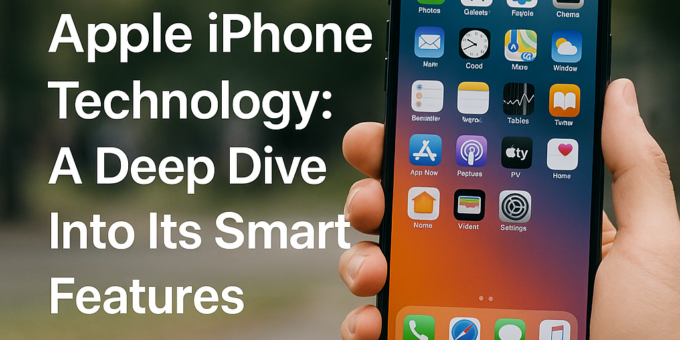
The Apple iPhone isn’t just a phone—it’s a finely-tuned marvel of modern engineering. Since its debut in 2007, it has redefined what we expect from a handheld device. At the heart of its evolution is the seamless blend of hardware and software that delivers a truly smart user experience. Today, iPhones are not only powerful tools but also intelligent companions that understand user intent, prioritize privacy, and enhance productivity like never before.
The Revolutionary Rise of Apple iPhone Technology
Back when Steve Jobs introduced the original iPhone, he called it “an iPod, a phone, and an internet communicator.” Little did we know it would become so much more. From voice control to real-time photo enhancement, the evolution of iPhone technology showcases Apple’s focus on innovation, simplicity, and user-centric design.
The smart features we admire today didn’t appear overnight. They’re the result of meticulous planning, advanced chipsets, and groundbreaking research. Apple’s closed ecosystem has allowed it to optimize every feature and update for a consistently fluid experience.
A Brief History of the iPhone: From 2007 to Now
The journey of the iPhone is a timeline filled with innovation. Early models focused on introducing the touchscreen, while recent versions boast AI-powered photography, AR capabilities, and advanced biometrics.
Each new generation brings substantial upgrades—not just in speed, but in intelligence. The iPhone 4 introduced the Retina display. The iPhone X changed everything with Face ID. More recently, the iPhone 15 Pro brought 3nm chip architecture into the mainstream.
iOS and the Power of Apple’s Operating System
The core of every smart feature lies in iOS. This proprietary operating system is finely optimized to work hand-in-hand with Apple’s hardware. With each iteration, iOS becomes more intuitive, offering:
-
Smart App Suggestions based on location and habits
-
Focus Modes that reduce distractions automatically
-
On-device intelligence that enhances privacy
iOS ensures that smart features don’t come at the cost of battery life or performance.
Aesthetic and Design Innovations Over the Years
Design isn’t just about looks—it’s about how it feels and functions. Apple’s design philosophy emphasizes simplicity, but under the hood, it’s complex magic. Features like edge-to-edge displays, Ceramic Shield glass, and aerospace-grade aluminum make the iPhone both beautiful and resilient.
The most recent iPhones also feature Dynamic Island, a creative way to blend hardware with live activities—truly smart design in action.
Retina Display and Super Retina XDR: What’s the Difference?
Apple’s Retina display technology was a game-changer. With pixel density so high the human eye can’t distinguish individual pixels, it made reading and viewing media a joy.
Now, with Super Retina XDR, the experience is elevated even further:
-
Higher contrast ratios
-
Improved HDR
-
True blacks with OLED panels
This results in stunning visuals, ideal for both entertainment and productivity.
Face ID and Touch ID: Biometrics Made Smart
Security meets convenience through Apple’s biometric features. Touch ID brought fingerprint recognition to the masses, while Face ID revolutionized security using a TrueDepth camera and 3D mapping.
These aren’t just gimmicks—they’re highly accurate and work even in varied lighting. Face ID can now even unlock your phone with a mask on, thanks to AI-driven updates.
Neural Engine and Machine Learning in iPhone
Apple’s Neural Engine is the powerhouse behind many smart features:
-
Photo and video analysis
-
Language processing for Siri and dictation
-
On-device personalization
This 16-core neural network processes trillions of operations per second, ensuring that your iPhone gets smarter the more you use it.
Siri: From Voice Assistant to Smart Companion
Siri has come a long way from basic voice queries. Today, Siri:
-
Understands context
-
Offers proactive suggestions
-
Controls your smart home
-
Integrates across all Apple devices
With on-device processing, Siri also gets faster while keeping your data private.
A15, A16, and A17 Bionic Chips: What They Really Do
Each new chip generation isn’t just about speed—it’s about intelligence. The A15 introduced a 6-core CPU with enhanced AI. The A16 improved energy efficiency. The A17, Apple’s first 3nm chip, redefined performance and graphics capabilities.
These chips enable:
-
Real-time photo enhancements
-
Lag-free AR experiences
-
Efficient battery usage
The Role of Augmented Reality in Apple’s Vision
Apple’s investment in AR is serious. With LiDAR scanners and ARKit, iPhones can:
-
Measure rooms with precision
-
Create 3D models for e-commerce
-
Play AR-enhanced games
And soon, with the introduction of Apple Vision Pro, your iPhone could become the ultimate AR companion.
Camera System: Computational Photography Explained
Gone are the days when megapixels ruled. Apple’s approach focuses on computational photography:
-
Smart HDR merges multiple exposures
-
Deep Fusion enhances textures and details
-
Machine learning adjusts images in real time
This technology makes even amateur photographers look like pros.
Night Mode, Cinematic Mode, and Deep Fusion
These features are a perfect blend of software and hardware:
-
Night Mode uses AI to brighten photos taken in the dark
-
Cinematic Mode adds depth-of-field effects to videos
-
Deep Fusion brings out sharp textures in medium light
All processed in milliseconds, intelligently.
iPhone and Health: Sensors That Save Lives
From the Health app to emergency sensors, iPhone is a wellness partner. Key features include:
-
Fall Detection
-
Heart rate monitoring via Apple Watch
-
Cycle tracking and sleep analysis
The iPhone can even detect a car crash and call for help. That’s smart technology in service of your safety.
Battery Management with Smart Charging
Apple uses adaptive charging algorithms that learn your routine. If you charge overnight, it’ll hold at 80% and top off before you wake up—preserving battery health.
This, combined with efficient chipsets, extends battery longevity significantly.
MagSafe: Wireless Charging and Accessory Innovation
MagSafe isn’t just about wireless charging. It’s a smart ecosystem:
-
Auto-aligning chargers
-
Snap-on wallets
-
Modular accessories like power banks
It’s Apple’s modular approach to making iPhones smarter through magnetism.
The iPhone Ecosystem: Integration with Apple Watch, Mac, and iPad
One of Apple’s smartest features is continuity. With it, you can:
-
Answer calls on a Mac
-
Copy on one device, paste on another
-
Auto-unlock Macs using Apple Watch
This seamless handoff across devices turns individual gadgets into a unified productivity suite.
iCloud and Seamless Data Synchronization
iCloud ensures your:
-
Photos
-
Contacts
-
Notes
-
Messages
…are all backed up and synced in real time. Even deleted data can be restored within 30 days. Smart, safe, and seamless.
Privacy as a Core Feature in iPhone Technology
Apple’s stance on privacy sets it apart. iPhones come with:
-
App Tracking Transparency
-
Mail Privacy Protection
-
Secure Enclave for biometric data
You’re in control of your data—and that’s no small feature in today’s world.
iMessage and FaceTime Encryption: How Safe Is It?
Both services use end-to-end encryption. Only you and your recipient can read or hear your messages. Apple cannot access this data—even if they wanted to.
And FaceTime now works with Android users via links, without compromising security.
Emergency SOS and Crash Detection Technology
Modern iPhones automatically detect car crashes and fall events. They:
-
Alert emergency services
-
Send your location
-
Notify emergency contacts
Even when you can’t respond, your iPhone can act for you.
iOS Accessibility Features That Empower Users
Inclusion is a hallmark of smart design. Apple includes:
-
VoiceOver
-
Magnifier
-
Sound Recognition
-
AssistiveTouch
These features ensure that everyone—regardless of ability—can use an iPhone with confidence.
Live Text and Visual Lookup: Next-Gen Utility
Live Text lets you copy text from photos. Visual Lookup identifies objects, animals, landmarks. These aren’t just party tricks—they save time, enhance productivity, and feel like magic.
Widgets and Customization: The User in Control
Widgets and Lock Screen customizations allow iPhones to look and work the way you want. Apple offers personalization while maintaining security—a delicate and smart balance.
Third-Party Apps and App Store Optimization
The App Store is curated to avoid malicious apps. Combined with App Review Guidelines, your iPhone remains safe even when you explore third-party software.
Sustainability and Environmental Responsibility
iPhones are becoming greener. With features like:
-
Recycled rare-earth elements
-
Carbon-neutral production goals
-
Durable hardware that lasts
Smart doesn’t just mean advanced—it means responsible.
5G, Wi-Fi 6E, and Beyond: The Connectivity Edge
iPhones support the latest in connectivity, ensuring fast and stable networks for streaming, downloads, and FaceTime calls—no matter where you are.
Apple iPhone and AI: A Symbiotic Future
AI isn’t just a buzzword. In iPhones, it powers:
-
Photo classification
-
Battery optimization
-
Contextual Siri suggestions
As Apple continues to invest in on-device AI, the future is bright and private.
Security Updates and Longevity of iPhones
Apple offers iOS updates for many years—far longer than competitors. This ensures:
-
Better security
-
New features
-
Extended device life
Which ultimately gives you more value for your investment.
Comparing iPhone to Competitors: Where It Excels
While Android devices offer flexibility, iPhones dominate in:
-
Long-term updates
-
Ecosystem integration
-
Hardware-software synergy
They’re not just phones—they’re portals to a smarter lifestyle.
What’s Next: Future of iPhone Technology
Expect more AI, AR, and sustainability. With Vision Pro integration and possible foldable iPhones on the horizon, the future looks sleek, smart, and surreal.
Apple iPhone Technology
From biometric security to AR-powered navigation, Apple iPhone technology exemplifies how far smartphones have come. These aren’t just incremental changes—they’re monumental shifts in how we interact with the world.
FAQs
What makes iPhone technology smart?
The integration of AI, machine learning, and custom chips like the A17 Bionic ensures smarter processing and user adaptability.
Is iPhone more secure than Android?
Yes, Apple’s closed ecosystem, frequent updates, and privacy-first design give it an edge.
What is the Neural Engine used for?
It handles AI tasks like facial recognition, photo enhancements, and voice processing.
Can iPhones detect emergencies automatically?
Yes, recent models can detect car crashes and falls, sending automatic alerts to emergency services.
What’s the benefit of MagSafe?
It offers smart charging and modular accessory use, all magnetically aligned.
Are Siri commands processed in the cloud?
No, many Siri commands are now processed on-device for privacy and speed.
You Can Also Read : Drive in Style: Top-Rated Luxury Car Gadgets and Accessories on Amazon
Apple iPhone technology is not just advanced—it’s smart, secure, and incredibly user-focused. With each update, Apple continues to lead the charge in delivering meaningful innovation that feels intuitive, purposeful, and futuristic. From saving lives to streamlining daily routines, the iPhone proves time and again that it’s far more than a phone.
